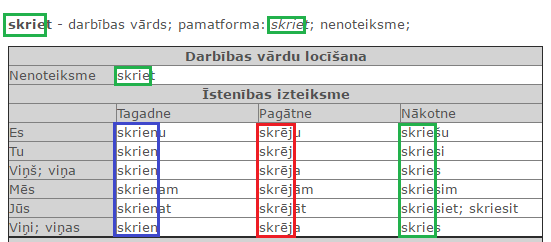You learned a new verb.
It most likely was the infinitive verb form that you learned.
But how do you use it in a sentence?
This post explains why you need to learn verb stems in Latvian and gives step-by-step instructions on how to look up verb stems.
When Latvians learn English, they learn to add the suffix -ed to regular verbs to get the past and perfect forms. So to learn becomes I learned and I have learned.
But then there are a bunch of irregular verbs that do not follow this rule.
So Latvians dutifully memorize lists of such verb triplets as ride/rode/ridden, run/ran/run, sleep/slept/slept, etc.
Unfortunately, there is no way to tell if an English verb is regular or irregular just by looking at its infintive form.
It’s similar in Latvian.
If you know just the infinitive verb form, you can use its stem (drop the -t ending) to construct the following sentences:
- the infinitive: Man patīk skriet. I like to run.
- the simple future: Es skriešu. I will run.
- the subjunctive: Es labprāt skrietu. I’d like to run.
If you want to talk about the present or the past, you also need to know the present and past stem of the verb.
If you know the present stem, you can construct the following sentences:
- the simple present: Es skrienu. I run.
- the debitive: Man jāskrien. I have to run.
- the imperative: Skrien! Run!
- the reported speech: Viņš skrienot. I was told he’s running.
If you know the past stem, you can construct the following sentences:
- the simple past: Es skrēju. I ran.
You can also derive participles of these stems to construct the complex tenses (e.g. Esmu skrējis. I have run.)
Hopefully, you now understand why it’s necessary to learn the present and past stems along with the infinitive form of the verb.
Unfortunately, there is no way to derive the present and past stems from the infinitive.
You’ll just need to look them up.
Step 1. Go to http://letonika.lv/groups/default.aspx?g=5&r=1100
Step 2. Enter the word and click Meklēt
Step 3. Write down the forms:
- Es / Īstenības izteiksme / Tagadne is the present stem (blue)
- Es / Īstenības izteksme / Pagātne is the past stem (red)
- Nenoteiksme is the infinitive (green)

What’s a stem, though?
When you inflect a word (i.e. change endings), the part of the word that changes is the ending and the part of the word that stays the same is the stem.
To get the infinitive stem, simply drop the -t ending from the infinitive verb form. So skriet becomes skrie to which you can add other endings.
The present and past stems are usually given in the first person singular (es – I) or third person singular (viņš/viņa/tas – he/she/it).
If the stems end in -u, simply drop it to get the stem. So skrienu/skrēju (I run/I ran) becomes skrien/skrēj.
Less commonly, the stems will be given in the third person as skrien/skrēja (he runs/he ran). You don’t have to change the present stem but you need to drop the -a ending from the past stem. So skrien/skrēja becomes skrien/skrēj.
In conclusion, if you learn a new verb in Latvian then you should learn it together with its present and past stems. If you do that, you will then be able to use it in a sentence yourself.
